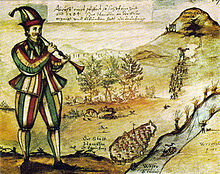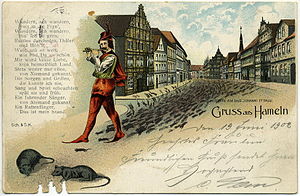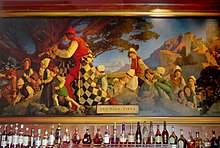
Back زمار هاملين Arabic Hameln siçovultutanı Azerbaijani Хамелнският ловец на плъхове Bulgarian হ্যামিলনের বাঁশিওয়ালা Bengali/Bangla Rattenfänger von Hameln Breton El flautista d'Hamelín Catalan Krysař (pověst) Czech Rottefængeren fra Hameln Danish Rattenfänger von Hameln German Ο αυλητής του Χάμελιν Greek


The Pied Piper of Hamelin (German: der Rattenfänger von Hameln, also known as the Pan Piper or the Rat-Catcher of Hamelin) is the title character of a legend from the town of Hamelin (Hameln), Lower Saxony, Germany.
The legend dates back to the Middle Ages. The earliest references describe a piper, dressed in multicolored ("pied") clothing, who was a rat catcher hired by the town to lure rats away[1] with his magic pipe. When the citizens refused to pay for this service as promised, he retaliated by using his instrument's magical power on their children, leading them away as he had the rats. This version of the story spread as folklore and has appeared in the writings of Johann Wolfgang von Goethe, the Brothers Grimm, and Robert Browning, among others. The phrase "pied piper" has become a metaphor for a person who attracts a following through charisma or false promises.[2]
There are many contradictory theories about the Pied Piper. Some suggest he was a symbol of hope to the people of Hamelin, which had been attacked by plague; he drove the rats from Hamelin, saving the people from the epidemic.[3]

- ^ Hanif, Anees (3 January 2015). "Was the Pied Piper of Hamelin real?". ARY News. Retrieved 6 June 2015.
- ^ "Pied piper – Definition and More from the Free Merriam-Webster Dictionary". Merriam-webster.com. Retrieved 7 December 2011.
- ^ "Deutungsansätze zur Sage: Ein Funken Wahrheit mit einer Prise Phantasie". Stadt Hameln (in German). Retrieved 29 December 2017.
© MMXXIII Rich X Search. We shall prevail. All rights reserved. Rich X Search